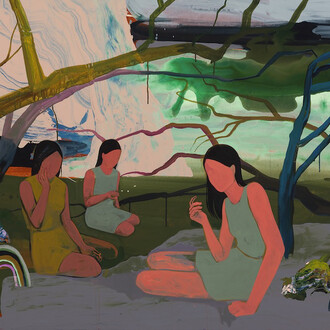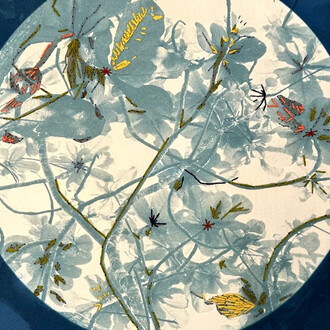Bruce Silverstein Gallery is pleased to announce our second solo exhibition for Sarah Sense, a contemporary Indigenous artist, curator, and writer. Featuring over twenty unique, hand-woven, sculptural photographs, I want to hold you longer examines the intricate and often fraught history of Indigenous basket-making and collecting. This exhibition considers the traditional practices of Chitimacha and Choctaw weaving and their purposes, reflecting on their personal and collective histories. Using historical, colonial documents and maps interwoven with contemporary photographs of ancestral lands, Sense reflects on the connections between individual memory and collective heritage. I want to hold you longer invites viewers to see each piece as a vessel, a conduit between personal and collective memory, carrying a genealogy, a history, and a profound desire for continuity and survival.
Works in this exhibition include documents from the American Antiquarian Society, MA, British, French, and American colonial maps from the British Library, and allotment maps from the Choctaw Cultural Center, OK. These colonial documents, when woven together with Sense’s landscape photographs of her ancestral homelands, entwine two known histories: one of historical marginalization, violence, dispossession, and survival, and one of responsibility, freedom, and joy. I want to hold you longer is a story of longing, connection, and memory. Sense takes us on a journey from her family’s collection to the collections of the Montclair Art Museum, NJ, the Brooklyn Museum, NY, and the Worcester Art Museum, MA.
During her visits to these collections, Sense recalls holding the baskets and feeling the emotion and hand of the weaver. Sense expresses: “The hands that wove the basket seem to be touching mine [...] I hold it longer and feel the words, ‘I want to hold you longer’”.
Twelve works from the series, categorized as “studies,” accompany twelve large pieces that signal specific baskets in the museum collections of the Montclair Art Museum, NJ, the Brooklyn Museum, NY, and the Worcester Art Museum, MA. Sarah recalls her experience holding these baskets:
When [I visited] the Montclair Art Museum archives in New Jersey with curator Laura Allen, I viewed eight Chitimacha baskets from the turn of the twentieth century. Six of them nest inside one another, each having their own pattern. I held the baskets with my hands, and again felt the emotion of holding the hand of the weaver. I saw the joy of weaving in the patterning but also felt the desperation of weaving...
These baskets are more than mere references for Sense; they are alive, having lived for generations. They hold the memories of a tradition passed down. Ultimately, these baskets draw a genealogical line between Sense’s contemporary moment and the past, weaving together personal and collective histories. Western historiography has long marginalized Indigenous histories, relegating them to the periphery of mainstream narratives shaped by colonial attitudes. Confined within the vast archives of Western institutions, these histories have been subjected to a cycle of erasure and invisibility. I want to hold you longer considers an alternative path for the future; the very inception of the series illuminates the personal connection that Sense brings to the materials within the archive, which is an act of disruption. No longer relegated to the past,Sense challenges viewers to confront historic collecting practices histories while providing avenues for healing. For Sense, weaving is a meditative process; with each movement of plaiting, twining, and coiling, she channels the spirit of her great-great-grandmother Delphine, her grandmother Chillie, her great-aunt Faye, and more. Through Sense’s work, we can understand that time is not linear. Instead, it is constantly shifting from present to past to future. As she weaves, she holds the hands of the weavers that came before her, and we witness the love, triumph, and persistence embodied in her work. Weaving these patterns is a direct tie to the weavings and cultural knowledge keepers who came before.
Sarah Sense (b. 1980) was raised in Sacramento, California. Her maternal grandmother is Choctaw from Oklahoma,and her maternal grandfather is Chitimacha from Louisiana. From her grandmother, she gained a love of baskets and an interest in practicing basket weaving herself. With the blessing of the Chairman of the Chitimacha Tribe, Sense began practicing her variation of the traditional method during graduate school at Parsons the New School for Design in 2004. While Director and Curator of the American Indian Community House in New York, Sense cataloged the AICH’s thirty- year history, inspiring her search for Indigenous art internationally. She has since traveled across North America, Central America, South America, Southeast Asia, the Caribbean, and Europe to learn more about the art of Indigenous communities. Landscape photography from her travels is an integral part of her weaving. Sense’s recent exhibitions this year include In our hands: native photography, 1890 – now, Minneapolis Museum of Art, MN; [Un]mapping: decolonial cartographies of place, Hood Museum at Dartmouth University, NH, and Interwoven power: native knowledge/native art, Montclair Art Museum, NJ. Her work is held in private and public collections, including the Hood Museum of Art at Dartmouth, the Montclair Art Museum in New Jersey, the Portland Museum of Art in Oregon, and the Rijksmuseum in Amsterdam.
















